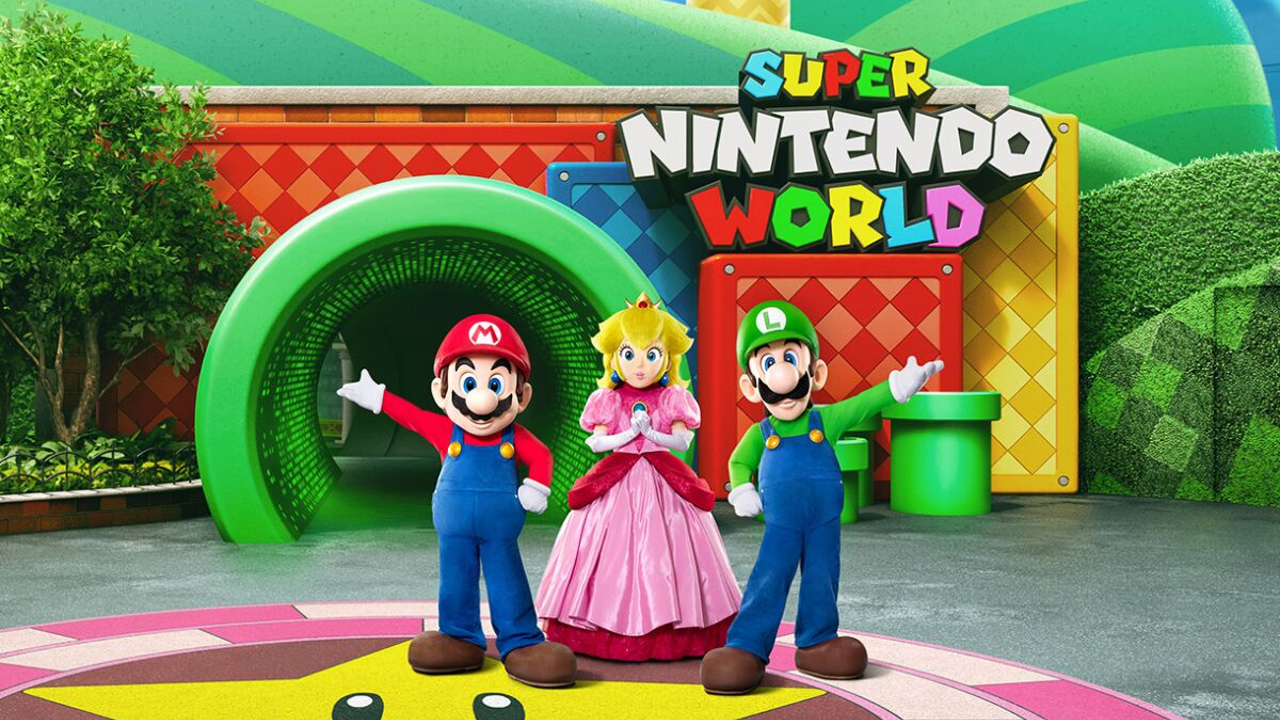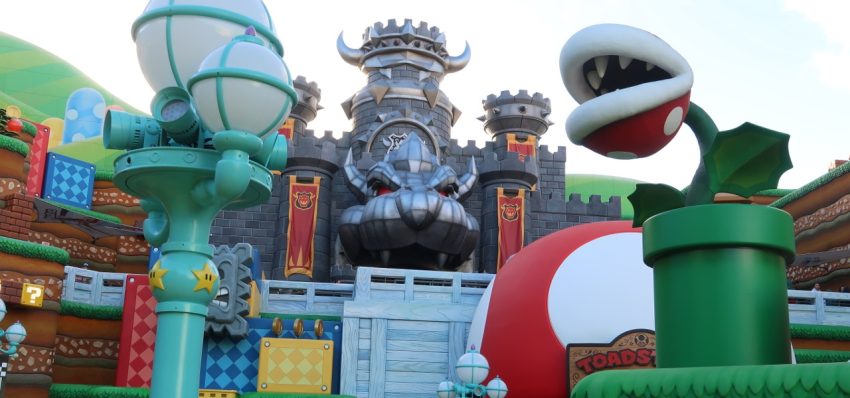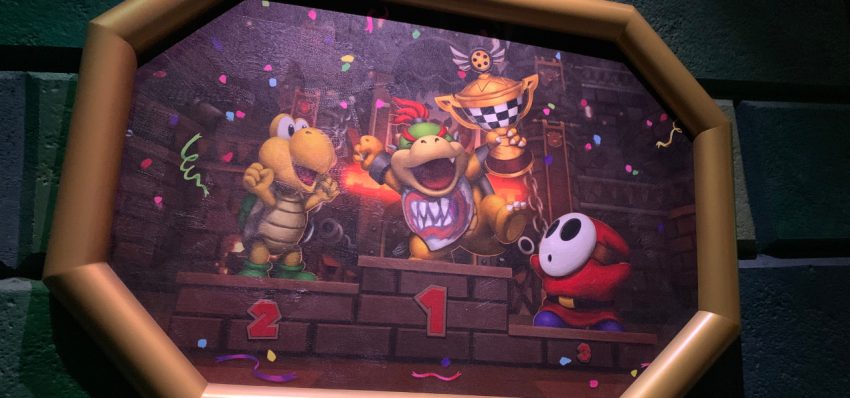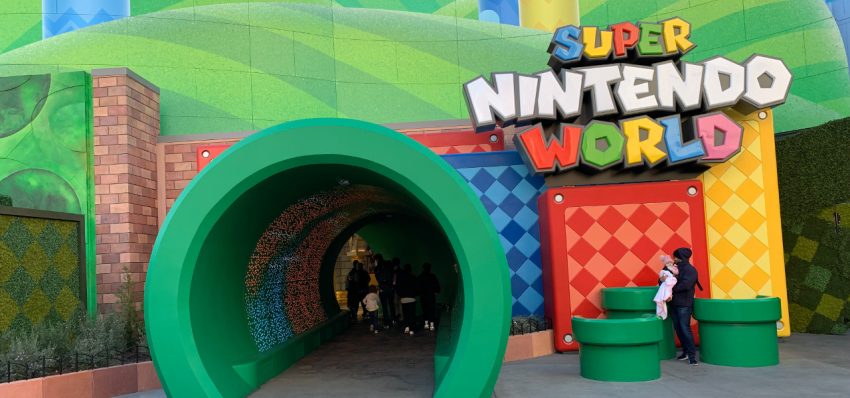Zelda Dungeon’s Impressions of Super Nintendo World at Universal Studios Hollywood!
Posted on April 15 2023 by Rod Lloyd

After years of anticipation, Super Nintendo World had its grand opening at Universal Studios Hollywood on February 17th, 2023. Promising “exhilarating entertainment with innovative technological achievements inspired by [Nintendo] characters,” Super Nintendo World looked to be the destination for Nintendo fans of all ages and a spectacular celebration of the worlds Nintendo has created.
A few weeks back, the Zelda Dungeon crew had the opportunity to step into Super Nintendo World and experience everything that the area had to offer, from attractions, to entertainment, to food. We rode the rides, we played the mini-games, and we ate the mushrooms. And now, having soaked everything in and given ourselves time to reflect on our time in the park, we’re ready to share all about our experiences with all of you.
So, please join us as take you on an expanded tour of Super Nintendo World, as we lay out the breathtakingly great, the tragically disappointing, and everything in between.
General Vibes & Attention to Detail

Tucked away in Universal Studios’ lower lot, Super Nintendo World is, by and large, inspired by Nintendo’s flagship series: Super Mario Bros.. The area entrance alone — from its signage, to the blocks & pipes scattered around, to the sweeping orchestral arrangement that calls to mind many Mario theme tunes — makes crystal clear the connection between the land and the Mario series. We’d imagine that most Zelda fans are also Mario fans, but, off the bat, one should recognize that Super Nintendo World relies heavily on the single Nintendo series rather than Nintendo’s catalog as a whole.
But don’t let that turn you away just yet! Super Nintendo World’s focus on Mario actually does a lot to heighten the desired theme park experience.
Park-goers enter Super Nintendo World in true Super Mario fashion, through a giant, green Warp Pipe. And upon exiting that Warp Pipe, you are immediately dropped into Princess Peach’s castle, inspired heavily by the structure’s appearance in Super Mario 64. The castle makes a fantastic first impression, as it highlights the craftsmanship and attention-to-detail evident throughout Super Nintendo World.
Everything from the elaborate architecture and ordainments, to the orchestral music that accompanies the area, to the dynamic paintings on the walls that tell the “story” of Super Nintendo World — wherein Bowser Jr. has stolen the priceless Golden Mushroom — achieves a high standard of quality and immersion that rivals even Disney’s most popular theme parks. You really feel like you’re in Princess Peach’s castle.
And that impeccable standard carries over to nearly every corner of the area. Everywhere you look, you are surrounded by Mario Bros. imagery come to life, with waddling Goombas, dancing Piranha Plants, and bouncing Mushroom Power-Ups occupying every inch of your periphery. You are now in the Mushroom Kingdom, and there’s something exciting to look at in every direction. The three-dimensional experience is likely one that will appeal to not only children but to the child inside every adult. Everyone, regardless of age, should be equally enthusiastic about what they are seeing and hearing.
As long-time fans of the Mario series, we felt right at home.
Super Nintendo World offers plenty of standard theme park distractions, from sight-seeing opportunities, to gift shops (more on those later), to photo-ops with costumed characters. The Mario Bros. themselves, Mario & Luigi, regularly appear at the land’s center to take pictures with excited guests. And the iconic Princess Peach operates like a Disney Princess, meeting fans in front of her castle and taking pictures with little girls dressed in pink. The costumes for these characters were some of the best we’ve ever seen at an amusement park, as they utilized animatronic face features and recorded voice clips to bring the video game characters to life.
Just walking around Super Nintendo World, taking in all the sights and sounds, seemed like a worthwhile experience.
But that’s not to say that there weren’t some issues with our visit.
One problem currently facing Super Nintendo World relates to space and crowd control, moreso than most theme parks our team has visited. The land, by the nature of Universal Studio’s overall lack of available real estate, is actually quite small. That means that, at most times of the day, park-goers will find themselves inside a packed crowd trying to take in everything Super Nintendo World has to offer. And on top of that, the land’s layout appeared poorly designed to accommodate larger crowds, with frequent funnels and bottlenecks throughout.
Such issues might explain why, for now at least, entrance to Super Nintendo World is by appointment only for most of any given day. If you’re early enough, you might be able to walk right in. But if you’re too late arriving to Universal Studios due to LA traffic, you’re going to need to book an appointment, and those appointment slots fill up fast.
Perhaps the crowds will dissipate more the farther we get from the grand opening. But for now, Super Nintendo World is hard to navigate because the available space is so limited and because the area’s layout seems poorly equipped to maintain crowd control.
But for all those issues, in a general sense, Super Nintendo’s atmosphere and charm are something to celebrate. One of our greatest fears when our favorite video games are adapted into television series, movies, theme parks, etc. is that the creatives behind those projects might care more about the potential financial gain than quality, accuracy, and respect to the source material. Super Nintendo Land eased those fears.

It was increasingly clear that great care was put into creating a Mario-themed park in ways Universal didn’t expressly need to. Plenty of obscure details and Easter Eggs, including mushroom-shaped benches and banana peel-shaped wet floor signs, kept our eyes — pardon the pun — peeled. And the various songs chosen for each area weren’t random or surface-level picks; for instance, the recreation of Bowser’s Castle features some of the best Bowser-themed songs in the series and the Mario Kart ride boarding area is scored by none other than the Main Menu theme from Mario Kart Wii.
With every step, a love of Nintendo and the worlds it’s created is felt in Super Nintendo World. The land’s greatest strengths are, without a doubt, its charm, craftsmanship, and attention-to-detail. And those qualities alone are worth the price of admission.
Mario Kart: Bowser’s Challenge

So, what is there to actually do in Super Nintendo World?
Well, speaking of Mario Kart, the area’s marquis attraction is Mario Kart: Bowser’s Challenge, a dark ride of sorts inspired by Nintendo’s long-running racing franchise.
Put in the driver’s seat of your very own go-kart, riders of Mario Kart: Bowser’s Challenge join Mario’s racing team, alongside series heroes like Luigi, Peach, and Toad; and they’re pitted up against the team of Bowser, Bowser Jr., and the Koopa Kids. A frenetic dark ride faithfully based on a beloved racing series, something akin to Roger Rabbit’s Car Toon Spin at Disneyland, with plenty of twists & turns and the same charm & attention-to-detail that made Super Nintendo World magical in the first place? That sounds like a slam dunk!
Unfortunately, the ride itself is hurt by the supposition that a video game-based ride must have an interactive component. Rather than just functioning as a standard dark ride, with riders passively experiencing a series predetermined thrills and set pieces on a track, Mario Kart: Bowser’s Challenge features a gamified AR (Augmented Reality) component, wherein riders don a headband — cutely modeled after a Mario cap — and an AR visor over their eyes. While the ride is in motion, Mario Kart elements like characters, Shells, and Item Blocks will appear in the visors as riders physically look around the physical space of the ride.
And that’s not all. Rather than just serve as simple set dressing that enhances the physical elements of the ride itself — like the scenery, animatronics, and video screens common in modern dark rides — the AR components instead facilitate the “game” element that riders are encouraged to engage with. Riders essentially use the AR visors to take aim and shoot Koopa Shells in the direction they are looking, with Bowser’s crew of baddies serving as the targets. Riders rack up coins for each successful hit, and they lose coins if they accidentally hit someone from Mario’s team. And on top of all that, riders are rewarded for turning their kart’s steering wheel in the right directions occasionally prompted within the AR environment.

In theory, the AR aspect of Bowser’s Challenge is a clever and technologically impressive way to bring the “game” portion of Mario Kart into a real-world experience. But in practice, it proves a folliful gimmick — and a bad game to boot — that simply distracts riders from the admittedly neat and awe-inspiring portions of a real amusement ride. Pardon the pun, but it’s like putting a hat on a hat; it’s redundant. Rather than simply giving riders the opportunity to experience a real-life Mario Kart race through motion, sight, and sound, like all the best dark rides out there, Bowser’s Challenge literally shoves visual noise in your face and tells you to look away from the cool stuff in the room. And one shouldn’t forget to mention that the AR visors themselves have an absurdly narrow field of function, meaning you’ll have to look almost directly at a virtual object if you want to see it in full.
And that’s a real shame. All the comic mischief you’d expect from Mario Kart is present in Bowser’s Challenge, but you just have to ignore the AR elements — its biggest advertised feature — to notice them. Classic MK tracks like Royal Raceway, Dolphin Shoals, and Rainbow Road are all represented, both in physical form through set design and on digital 3D screens scattered throughout the ride space. If you’re a fan of the series or of Super Mario as a whole, you’ll spot plenty of familiar faces and hear plenty of familiar tunes throughout the race.
Although interactive rides such as this have worked in the past, like Buzz Lightyear Astro Blasters in Disneyland, the AR component of Mario Kart: Bowser’s Challenge makes it inconsistent as far as quality, and at times too overcomplicated for the average park-goer. We can only wonder what the ride could have been if the AR was taken away and the developers were not so overambitious. In all honesty, we very likely would have been more satisfied if that was case. Just give us a few fun thrills — like the kart spinning out because it hit a banana peel or the kart being lifted up by a Lakitu because it fell off the track — and let us enjoy the immersive Mario fan service in peace.

The ride’s queue was, however, worth seeing for Bowser’s Study, a room that the line goes through. You see, the queue takes riders through a charming, little area based on Super Mario World 2: Yoshi’s Island (complete with TV screens that show Yoshis waving at guests) and then into King Koopa’s castle. The castle entrance itself will inspire awe, with its detailed architecture and the massive Bowser statue just beyond the door. But the true treat comes a few rooms later, as guests move into Bowser’s Study.
The study features multiple Mario series Easter Eggs, including Bowser’s gigantic throne, art adorning the walls, and multiple bookcases featuring titles like Moo Moo Farmer’s Almanac and Dungeonkeeping for Dum Dums. The room pays homage to just about every game in the sprawling Mario series in some way, with detailed dioramas and true-to-scale recreations of objects from the games. It even makes use of digital elements that make the space feel alive, like digital screens on some of the book shelves that show cheeky Boos laughing and dancing around.
We honestly think that Bowser’s Castle would have worked far better without a ride at all.
A walkthrough tour of the castle — in the same vein as the Sleeping Beauty Castle walkthrough from Disneyland — would have worked far better than what we ultimately got with Mario Kart: Bowser’s Challenge. Guests could have simply walked through the castle, seeing all of Bowser’s collected odds and ends over the years brought to life, all while “story” events took place outside the windows. After all, Toadstool Cafe (which we’ll discuss later) did something similar, with Bowser attacking every half hour as if Super Mario Galaxy was happening just outside.
Replacing Mario Kart: Bowser’s Challenge with a walkthrough attraction would have also made guest traffic far more fluid, as there would have been no ride to board, no hiccups in explaining how the AR works, and no need to make sure you have your Mario AR caps on. Guests could have just walked through and enjoyed recognizing different parts of Mario Bros. history.
We waited in the line for Mario Kart: Bowser’s Challenge twice; the first time took two and a half hours and the second time took two hours. Neither time was worth it. When all is said and done, the ride itself — despite some cool technology and the fan service of its queue — is worth a ten-minute wait at best. At the end of the day, we’d rather just play Mario Kart.
Power-Up Bands & Key Challenges

Mario Kart: Bowser’s Challenge is just one of the major attractions at Super Nintendo World, but it’s also the only one available to all park-goers. The other major attractions, collectively known as the Key Challenges, require the additional purchase of the Universal Studios Power-Up Band.
The Power-Up Bands, available to purchase from Universal Studios gift shops for roughly $40 USD, altogether serve as one’s access pass to Super Nintendo World’s app-based experiences, to the many interactive elements within the land, and to the land’s biggest attractions beyond Bowser’s Challenge. They’re much like Wizarding World of Harry Potter’s Interactive Wands or Disney Parks’ Play App, but they go a step further in locking major games and attractions behind a pay wall.
But let’s start at the Nintendo World app and work our way up. Upon purchase, the Power-Up Bands can be linked to the Super Nintendo World portion of the Universal Studios app. Park-goers are invited to join a team represented by a Super Mario character (Zelda Dungeon managing editor Rod joined Team Luigi), and they are then encouraged to collect Stamps by performing certain actions, bank virtual coins, and rack up points for their team. A leaderboard, updated periodically throughout the day, shows how your team is performing against the others and where you stand in the overall rankings.
The team aspects and leaderboards of the app are quite abstract in their execution and presentation. But the long and short of it is that the app serves as a way to encourage Power-Up Band users to engage with the interactive elements of the area.
And those interactive elements are one of Super Nintendo World’s defining features. Power-Up Band owners are able to pound their wrist against the bottom of Question Mark Blocks to collect coins and trigger certain audio-visual Easter Eggs throughout the land. Our personal favorite Easter Eggs included hidden 8-bit Mario characters that appear when certain walls are touched and a Bowser Jr. Block that pranked park-goers with flashing lights and bursts of air.
Whether or not these interactive distractions are worth the $40 USD price tag depends on who you ask, but we can’t deny the fun in finding hidden secrets throughout Super Nintendo World. We’d imagine this part of the experience would be a hit with kids! But for all its fun, we do still wish the area had a greater variety of interactive objects; there’s definitely an overabundance of Bricks and Coin Blocks.
And that brings us to the Key Challenges themselves, an assortment of four midway-type games, each based around an enemy from the Super Mario series. We’ve got Goomba Crazy Crank, Koopa Troopa POWer Punch, Piranha Plant Nap Mishap, and Thwomp Panel Panic. Completing a Key Challenge will earn you a key, with three keys total required for a special attraction we’ll discuss later.
Each Key Challenge has one simple goal that can be completed in just a minute or two. Goomba Crazy Crank involves quickly turning a large crank to cause a Goomba to stumble, Koopa Troopa POWer Punch involves hitting a POW Block with one’s Power-Up Band at the right time to knock down a Koopa, Piranha Plant Nap Mishap involves turning off a number of large alarm clocks to put a Piranha Plant back to sleep, and Thwomp Panel Panic involves flipping colored buttons on a large touch screen. While the former two challenges are meant to be completed by one guest at a time, the latter two can be completed in groups.
The Key Challenges’ target demographic seems to be children, as the tasks themselves are very easy to accomplish and the margin of error is extremely lenient. That’s not to say that everyone will come out victorious — you have to get back in line if you fail, by the way, even if you’re under six — but the overwhelming majority of players we witnessed won their key. With that said, while we’d imagine the challenges would be a huge hit with kids and their families, they probably aren’t something a hardened Nintendo veteran would find engaging. They are mildly amusing at most for adults and are therefore not worth the $40 USD price tag in our opinion.
As mentioned above, the Key Challenges are only accessible to guests who bought a Power-Up Band. And that decision seems to have been partially influenced by the lack of space allotted to these games in the land itself. Because real estate in Super Nintendo World is already sparse, we imagine park planners had to keep the Key Challenge lines as short as possible. Limiting the number of people who are even able to participate in the Key Challenges by requiring the Power-Up Bands appears to be their solution. The lines sure are short for this reason (20 minutes at most), but one has to pay to play.
As with every application of Power-Up Bands, the question surrounding these challenges is whether or not they’re worth $40 USD. Our answer is that they are not, unless you are a parent or are yourself a child.
Bowser Jr.’s Shadow Showdown

So you’ve collected three keys from the available Key Challenges. What do you do with them? Well, the keys are needed to access Super Nintendo World’s best attraction: Bowser Jr.’s Shadow Showdown.
Slapping your Power-Up Band against a keyhole outside Bowser Jr.’s little castle right next to the Mario Kart ride entrance will let you inside (a Universal Studios employee serves as valet). The interior of the castle, essentially a line queue for the attraction, carries much of the same charm and excitement as Bowser’s Study from the Mario Kart queue. You’ll find replica versions of iconic Mario items like Bowser Jr.’s paintbrush and his Clown Car, you’ll see original artwork glorifying the junior Koopa, and you’ll discover a few unique interactive objects. Bowser Jr.’s castle is just more of a reminder that Super Nintendo World needs more walkthrough attractions, honestly.
But the main event of this whole area is Shadow Showdown, an interactive attraction like we’ve never seen before.
Upon reaching the end of the queue, groups of about 20 guests are spread out and directed to stand in front of a large, panoramic video screen. Spotlights shone from behind will then cast shadow silhouettes of each guest onto the video screen, meaning you’ll see your own shadow directly in front of you. And that shadow’s literally the name of the game.
Shadow Showdown features technological wizardry like we’ve never encountered, as a player’s shadow, cast on the video screen, is used to interact with elements on the video screen itself in real time. Think of it this way: your shadow, your silhouette, is like a Super Mario character; and you must avoid obstacles on a 2D plane like Mario would in order to defeat Bowser Jr. and his goons.
Players, via their shadows, use their arms to swat away balloons and falling Bomb-ombs, they duck to avoid incoming Bullet Bills, and they jump up into the air to smash Question Mark Blocks. In true Mario Bros. fashion, if your shadow is hit by a baddie, it shrinks in size; so you’ll need to collect a Mushroom in order to grow back to normal size. It’s all very charming and fun. And the shadow-based interface may not have perfect precision, but it works surprisingly, surprisingly well.
Bowser Jr.’s Shadow Showdown was, without a doubt, the most enjoyable attraction at Super Nintendo World.
The whole experience lasted only a few minutes, but the combination of a charming line queue, state-of-the-art technology that felt more like an innovation than a burden, and a presentation that made the most of its source material made Shadow Showdown one of Nintendo World’s few true triumphs. As with all activities related to the Power-Up Bands, one must consider whether or not Shadow Showdown is worth the $40 USD and the time needed to complete three Key Challenges. But, when all is said and done, this attraction is our biggest recommend.
Food & Merch

When it comes to theme park food, one can usually have pretty low expectations. Churros, pretzels? Maybe burgers or pizza? Nothing too exciting. After all, not every amusement park can have culinary strengths of Disney Parks (and even Disney has its low points when it comes to food).
Universal Studios has always impressed in this arena, even before the opening of Super Nintendo World. Whether it’s the Butterbeer in the Harry Potter area or the Krusty Burger in the Simpsons area, we’d argue that the food is one of the best ways the park allows you to escape into the fantasy of visiting the worlds depicted. Super Nintendo World is no exception.
The food at Super Nintendo World’s chief eatery, Toadstool Cafe, fits well with the theme of the Mario franchise. Every dish is either Italian, mushroom-involved, mushroom-shaped, a play on words, or even all four. Although Toadstool Cafe requires a reservation (via being there in person the morning of the day you want a reservation for), it is a fantastic place once you get inside. You are surrounded by Toads in virtual windows as you wait for your food, Bowser attacks “outside” every thirty minutes, and the decor is nothing short of adorable. And not only did our mushroom soup come in a Mushroom Power-Up bowl, but it was also the best mushroom soup we’ve ever had.
Beyond the main courses of Toadstool Cafe, Super Nintendo World (technically right outside the land’s entrance) is also home to a Super Mario snack stand. The main draw of the snack stand is its Mario-themed Fruity Cream Soda collection, with flavored drinks based on the Mario Brothers and Princess Peach. And, in true theme park faction, park-exclusive collectible Mushroom-shaped sippy-cups and Power Star-shaped popcorn buckets are available too.
The merchandise of Super Nintendo World — (Nintendo merch is available in gift shops throughout the park) — wasn’t really anything we hadn’t seen before, with its collection of clothing, pins, and plush dolls. But there are several gems if you really look, such as Boo headbands that mimicked Disney’s Mickey Mouse ears and traffic signs warning of Banana Peels and Red Shells. Being in a store that has all these things gathered in one place, with crowds of people browsing at once, definitely is enough to prove how lucrative this section of Universal Studios will be.
Final Thoughts

In so many ways, Super Nintendo World radiates joy and gratification for long-time Nintendo fans and casual attendees alike. Even before you travel through the first warp pipe, it’s impossible not to be wowed by the area’s bright colors and dynamic objects in the distance as you descend the series of escalators taking you down to the entrance.
For some of the Southern California locals in our group, Universal Studios Hollywood was not worth the price of admission until Super Nintendo World became a part of it. Sure, the area’s newness and popularity make it overcrowded in a way the developers did not anticipate, and the land does rely quite a bit on gimmicks and a $40 USD wristband, but it’s a once-in-a-lifetime experience for Nintendo fans of all ages. You should definitely consider making Super Nintendo World part of your adventure if you have the opportunity.
Just watch out for wild Pikmin who may steal your coins…

By the way, the small inclusion of a Nintendo franchise outside Super Mario Bros. does give us hope that The Legend of Zelda will be represented in Super Nintendo World one day in the future. Perhaps one day Revenge of the Mummy – The Ride, sitting adjacent to Super Nintendo World, will be repurposed as a Zelda coaster. Or, with Universal drawing from so many pop culture sources for its Halloween Horror Nights seasonal walkthrough attractions, maybe we’ll see a Shadow Temple haunted house pop up some October down the road.
Heck, maybe Zelda will be represented at Universal Orlando when Super Nintendo World opens there in Summer 2025, as has been speculated recently.
But until that day comes, we’re still glad to have Super Nintendo World at Universal Studios Hollywood. Having a destination for Nintendo fans is a dream come true!
This article includes contributions from Zelda Dungeon senior editor Alexandria Weber. We’d also like to thank Locke, Rachel “Z1”, Kieran O’Connor, and Trouble Toast for experiencing the park with us.

Rod Lloyd is the Editor-In-Chief at Zelda Dungeon, overseeing the news and feature content for the site. Rod is considered the veteran of the writing team, having started writing for Zelda Informer in 2014 as a Junior Editor. After ZD and ZI officially merged in 2017, he stepped into the Managing Editor role and has helped steer the ship ever since. He stepped up to lead the writing team as Editor-In-Chief in 2023.
You can reach Rod at: rod.lloyd@zeldadungeon.net








































